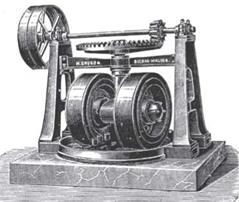Figure 6.8 shows a ring-roller mill invented by F. E. Huntington in 1883 to grind goldbearing quartz ores to liberate the gold before amalgamating it on tables. The Huntington mill was a roller mill similar to an arrastra, but centrifugal force, instead of gravity, drove its grinding action. It had three suspended flat rollers that swung radially outward against a horizontal steel die as the drive wheel rotated and ground the ore that was fed into the drive wheel’s path. Pulverized ore escaped from the mill through screens placed above the level of the viscous pulp and flowed by a launder to the copper amalgamating tables. The 1.5-m Huntington mill ground up to 20 tons in 24 hours through a 30-mesh (600-pm) screen. It rotated at 70 rpm and used up to 8 kW. The power required by a 2-m mill crushing 75 tpd of -6 mm jig tailings to -1 mm was 10 kW. Centrifugal pendulum mills were soon used for clinker grinding. The Atlas Portland Cement Company reported that a 30-kW Huntington mill reduced 2.5 tph of 12-25 mm cement clinker to 92% passing 150 pm (Eckel 1905).
|
|
FIGURE 6.7 Gruson vertical roller mills (Chilean mills) in 1890 (Foster 1894)
|
TABLE 6.1 Characteristics of Chilean mills
|
The Griffin mill, also shown in Figure 6.8, used a similar principle but had a single roller driven directly at its upper end. This mill was used in the late 19th century for grinding portland-cement clinker.
In 1989, Horst Brundiek wrote the history of dry roller mills, which are used in the cement and coal industries. He worked with Loesche GmbH for 40 years and patented many inventions that used roller mills. Extensive use has been made of that history in writing this section, and we acknowledge his paper entitled “The Roller Grinding Mill—Its History and Current Situation” as the source of much of our information.
[In the cement industry] the roller grinding mill is a machine in which the grinding surface is annular. Grinding bodies [rollers or balls] roll on it. The grinding bodies are pressed down on the grinding surface either by their own weight, or by centrifugal force, by springs, or by hydraulic or pneumatic systems. Both the driving surface and the grinding bodies may be driven. (Brundiek 1989)
[In the ore industry] the principle of the roll crusher is that twin rolls, not in contact, revolve so that the upper surfaces move toward each other. Friction between the rolls and fragments inserted between them will be sufficient to draw in the fragments and crush them till they pass the pre-determined gap. (Lebeter 1949b)
Rollers have been operated in many ways in dry roller mills. The different methods of operation were defined by G. Tarjan (1981) and are shown in Figure 6.9. Three roller mills—the Maxecon ring-roller, the Raymond centrifugal ring-roller, and the Fuller ring-ball— were used in the United States at the start of the 20th century for grinding softer rocks such as phosphates and coal (see Figure 6.10).

